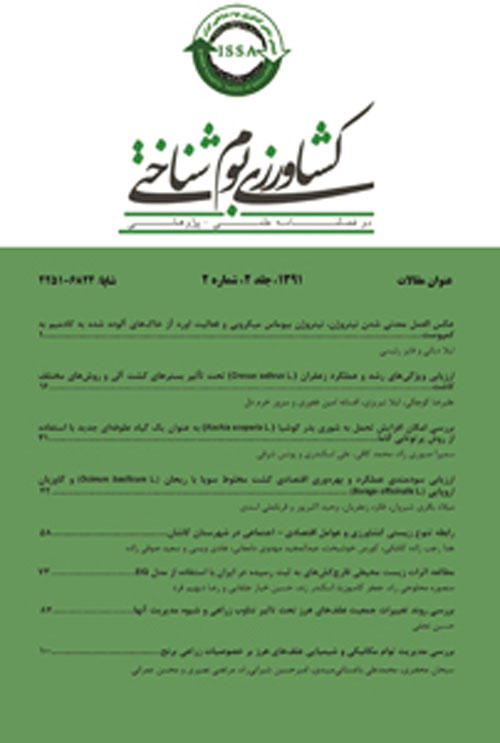Ecological management of the diamondback moth (Plutella xylostella (L.)) using trap cropping strategy
Author(s):
Abstract:
Introduction
In recent years, the diamondback moth (Plutella xylostella) has had some outbreaks in Iran (Afiunizadehand Karimzadeh, 2015). As a consequence of the development of insecticide resistance in P. xylostella populations and high insecticide residue on the crops, alternative, ecological and sustainable pest management strategies are urgently needed (Talekar and Shelton, 1993). Cultural control is simple, applied and compatible with other ecological methods and, hence, it can be used in integrated pest management. Trap cropping is a cultural and ecological pest management strategy that has been used increasingly in recent years (Shelton and Badenes-Perez, 2006).The present study is aimed at examining an ecological management of P. xylostella using native plants as trap crops in common cabbage.Materials And Methods
For this purpose, an experiment with six treatments was performed in a 0.5-ha field of common cabbage located in Falavarjan (Isfahan Province, central Iran). In each 100-m2 plot, the first two rows were planted with a trap crop, including Chinese cabbage, white mustard, turnip, black radish, and a mixture of all the aforementioned trap crops. Common cabbage was considered as the control. The treatments were replicated four times in a randomized complete block design. Random sampling was performed fortnightly from transplantation to harvest on 10 plants of main crop (common cabbage) per plot looking for P. xylostella larvae and pupae, and on three plants of trap crop per plot looking for P. xylostella adults.Results And Discussion
For this purpose, an experiment with six treatments was performed in a 0.5-ha field of common cabbage located in Falavarjan (Isfahan Province, central Iran). In each 100-m2 plot, the first two rows were planted with a trap crop, including Chinese cabbage, white mustard, turnip, black radish, and a mixture of all the aforementioned trap crops. Common cabbage was considered as the control. The treatments were replicated four times in a randomized complete block design. Random sampling was performed fortnightly from transplantation to harvest on 10 plants of main crop (common cabbage) per plot looking for P. xylostella larvae and pupae, and on three plants of trap crop per plot looking for P. xylostella adults.Conclusion
Considering the great concerns over overuse of chemical insecticides, it is necessary to use the cultural procedures of pest management, such as trap cropping. Trap cropping provides a simple and applied tool, which is compatible with other ecological pest management strategies. Keywords:
Language:
Persian
Published:
Journal of Agroecology, Volume:6 Issue: 2, 2017
Page:
215
magiran.com/p1680999
دانلود و مطالعه متن این مقاله با یکی از روشهای زیر امکان پذیر است:
اشتراک شخصی
با عضویت و پرداخت آنلاین حق اشتراک یکساله به مبلغ 1,390,000ريال میتوانید 70 عنوان مطلب دانلود کنید!
اشتراک سازمانی
به کتابخانه دانشگاه یا محل کار خود پیشنهاد کنید تا اشتراک سازمانی این پایگاه را برای دسترسی نامحدود همه کاربران به متن مطالب تهیه نمایند!
توجه!
- حق عضویت دریافتی صرف حمایت از نشریات عضو و نگهداری، تکمیل و توسعه مگیران میشود.
- پرداخت حق اشتراک و دانلود مقالات اجازه بازنشر آن در سایر رسانههای چاپی و دیجیتال را به کاربر نمیدهد.
In order to view content subscription is required
Personal subscription
Subscribe magiran.com for 70 € euros via PayPal and download 70 articles during a year.
Organization subscription
Please contact us to subscribe your university or library for unlimited access!


